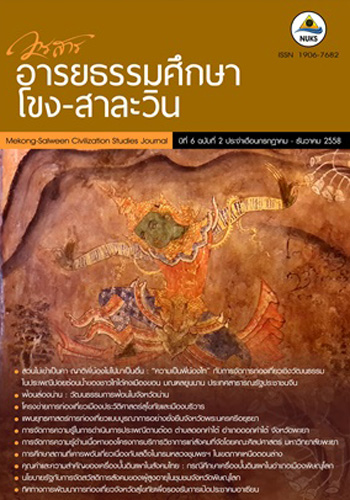ข้อตกลง
1. บทความทุกบทความจะได้รับการพิจารณาจากผู้ทรงคุณวุฒิ (Peer review) ที่ตรงตามสาขาวิชา โดยทุกบทความจะต้องผ่านการพิจารณาจากผู้ทรงคุณวุฒิ อย่างน้อยบทความละ 3 ท่าน
2. บทความ ข้อความ ภาพประกอบ และตารางใด ๆ ที่ตีพิมพ์ในวารสารอารยธรรมศึกษา โขง-สาละวิน เป็นความคิดเห็นส่วนตัวของผู้เขียน กองบรรณาธิการไม่จำเป็นต้องเห็นด้วยเสมอไป และไม่ใช่ความรับผิดชอบของ กองส่งเสริมศิลปวัฒนธรรม มหาวิทยาลัยนเรศวร ถือเป็นความรับผิดชอบของผู้เขียนแต่เพียงผู้เดียว
3. บทความจะต้องไม่เคยตีพิมพ์เผยแพร่ที่ใดมาก่อน และไม่อยู่ระหว่างการพิจารณาของวารสารฉบับอื่น หากตรวจสอบพบว่ามีการตีพิมพ์ซ้ำซ้อน ถือเป็นความรับผิดชอบของผู้เขียนแต่เพียงผู้เดียว
4. บทความที่ส่งถึงกองบรรณาธิการ ขอสงวนสิทธิ์จะไม่ส่งคืน
คุณค่าและความสำคัญของเครื่องปั้นดินเผา ในสังคมไทย : กรณีศึกษาเครื่องปั้นดินเผา ในอำเภอเมืองพิษณุโลก
Keywords:
เครื่องปั้นดินเผา, พิษณุโลก, ศิลปวัตถุ, คติชนอมุขปาฐะ, Pottery, Phitsanulok, Art Object, Non-Verbal FolkloreAbstract
บทความนี้มีวัตถุประสงค์เพื่อ 1) รวบรวมและจัดจำแนกเครื่องปั้นดินเผาในแหล่งสะสมอำเภอเมือง จังหวัดพิษณุโลก 2) ศึกษาวิเคราะห์บทบาทหน้าที่ของเครื่องปั้นดินเผาในฐานะคติชนประเภท อมุขปาฐะ โดยกำหนดขอบเขตในการเก็บรวบรวมข้อมูล เป็นกรณีศึกษาจากเครื่องปั้นดินเผาที่อยู่ในแหล่งสะสมในอำเภอเมืองพิษณุโลก จำนวน 6 แห่ง ได้แก่ พระราชวังจันทน์ พิพิธภัณฑ์พุทธชินราช วัดราชบูรณะ สำนักศิลปะและวัฒนธรรม มหาวิทยาลัยราชภัฏพิบูลสงคราม หอสมุดเทศบาลนครพิษณุโลก และพิพิธภัณฑ์พื้นบ้านจ่าทวี มีระยะเวลาในการเก็บข้อมูลตั้งแต่เดือนมกราคม 2554-ธันวาคม 2556 สำหรับการวิเคราะห์บทบาทหน้าที่ของเครื่องปั้นดินเผา ประยุกต์ใช้ทฤษฎีบทบาทหน้าที่ของวิลเลียม บาสคอมเป็นกรอบในการศึกษาผลการศึกษาพบว่า สามารถรวบรวมเครื่องปั้นดินเผาจากแหล่งสะสมทั้ง 6 แห่ง ที่เป็นกรณีศึกษา ได้ทั้งหมด 2,008 ชิ้น นำมาจัดจำแนกประเภทออกตามหน้าที่การใช้สอยได้เป็น 10 กลุม่ คือ 1) พระพุทธรูปและเครื่องราง 2) เครื่องใช้ในพิธีกรรม 3) ชิ้นส่วนทางสถาปัตยกรรม 4) ภาชนะบรรจุเครื่องดื่ม 5) สำรับอาหาร 6) เครื่องใช้ในครัว 7) ภาชนะเก็บกักและถนอมอาหาร 8) เครื่องใช้ทั่วไป 9) ของเล่น และ 10) เบี้ย
จากการศึกษาบทบาทหน้าที่ของเครื่องปั้นดินเผาในฐานะคติชนประเภทอมุขปาฐะพบว่า เครื่องปั้นดินเผามีบทบาทหน้าที่สำคัญในสังคมไทย 4 ประการ ได้แก่ 1) เป็นเครื่องมือ เครื่องใช้ที่อำนวยความสะดวกในชีวิตประจำวัน 2) เป็นสิ่งแสดงถึงอัตลักษณ์ของกลุ่มชน 3) เป็นพาหะวัตถุที่เชื่อมโยงมนุษย์กับมิติเหนือโลก และ 4) เป็นแหล่งเรียนรู้สำหรับชนรุ่นหลังได้ศึกษาสังคมวัฒนธรรมและวิถีชีวิตไทยในอดีต
Values and Importance of Pottery in Thai Society : A Case Study of Pottery in Mueang District, Phitsanulok
This article aims to 1) collect and categorize pottery found in various areas in MueangPhitsanulok district and 2) analyze the roles of pottery as nonverbal folklore in Thai society. The scope of this study is limited to six areas which are 1) Wang Chan Palace 2) Buddhachinaraj Museum 3) Ratchaburana Temple 4) Art and Culture Center, PibulsongkramRajabhat University 5) Phitsanulok Municipal Library, and 6) Sergeant Major Thawee Folk Museum. The data were collected during January 2011 - December 2013 and analyzed by drawing on “Four Functions of Folklore” proposed by William Bascom.
It was found that there were 2,008 pieces of pottery found in six areas of Mueang district, Phitsanulok.In addition, the result showed that there were ten main groups of functions: 1) Buddha image and amulet, 2) ritual appliances, 3) architectural parts, 4) drinking containers, 5) tray of food, 6) kitchen utensils, 7) food storage and preserved containers, 8) general utensils, 9) toys, and 10) cowrie.
Regarding the roles of pottery as non-verbal folklore in Thai society, it was found that there were four main roles which are 1) used as tools that facilitate daily life, 2) used to show the identity of the community, 3) seen as a mediator between the human and the mythological dimension, and 4) seen as valuable sources of learning about society, culture, and lifestyles of Thai people in the past for the next generations.







